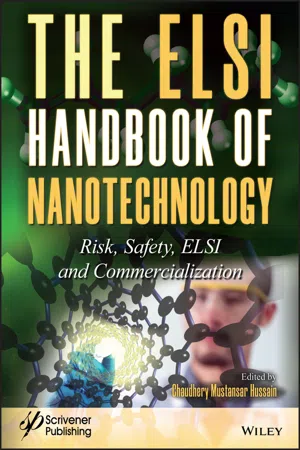
The ELSI Handbook of Nanotechnology
Risk, Safety, ELSI and Commercialization
- English
- ePUB (mobile friendly)
- Available on iOS & Android
The ELSI Handbook of Nanotechnology
Risk, Safety, ELSI and Commercialization
About This Book
This Handbook focuses on the recent advancements in Safety, Risk, Ethical Society and Legal Implications (ESLI) as well as its commercialization of nanotechnology, such as manufacturing. Nano is moving out of its relaxation phase of scientific route, and as new products go to market, organizations all over the world, as well as the general public, are discussing the environmental and health issues associated with nanotechnology. Nongovernmental science organizations have long since reacted; however, now the social sciences have begun to study the cultural portent of nanotechnology. Societal concerns and their newly constructed concepts, show nanoscience interconnected with the economy, ecology, health, and governance. This handbook addresses these new challenges and is divided into 7 sections: Nanomaterials and the Environment; Life Cycle Environmental Implications of Nanomanufacturing; Bioavailability and Toxicity of Manufactured Nanoparticles in Terrestrial Environments; Occupational Health Hazards of Nanoparticles; Ethical Issues in Nanotechnology; Commercialization of Nanotechnology; Legalization of Nanotechnology.
Frequently asked questions
Information
1
Nanomaterials and the Environment
1.1 Introduction
1.1.1 Overview of Nanomaterials


| Sr. no. | Nanomaterials | Synthesis methods | Examples |
| 1. | Metal NMs | Photochemical, Electr... |
Table of contents
- Cover
- Table of Contents
- Preface
- 1 Nanomaterials and the Environment
- 2 Highly Efficient Graphene-Based Nanocomposites for Environmental Application
- 3 A Concise Account of the Studies Conducted on the Transport, Fate, Transformation and Toxicity of Engineered Nanomaterials
- 4 Nanotechnologies and Advanced Smart Materials: The Case of Architecture and Civil Engineering
- 5 Life Cycle Environmental Implications of Nanomanufacturing
- 6 Addressing Nanotoxicity: Green Nanotechnology for a Sustainable Future
- 7 Nanotechnology: Occupational Health Hazards of Nanoparticles and Legalization Challenges
- 8 Bringing Awareness to the Darker Side of Nanoparticles
- 9 Mode of Transfer, Toxicity and Negative Impacts of Engineered Nanoparticles on Environment, Human and Animal Health
- 10 The Impact of Nanomaterials in Aquatic Systems
- 11 Nanotechnology in the Dairy Industry: Benefits and Risks
- 12 A Survey of Nanotechnology for Rocket Propulsion: Promises and Challenges
- 13 Toxicity and Regulatory Concerns for Nanoformulations in Medicine
- 14 A Way to Create a Sustainable Environment: Green Nanotechnology – With an Emphasis on Noble Metals
- 15 Modern Development with Green Polymer Nanocomposites: An Overview
- Index
- End User License Agreement